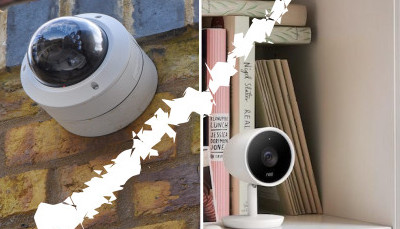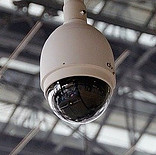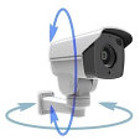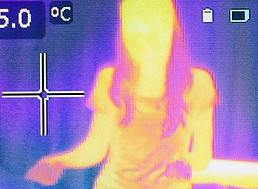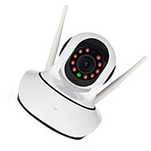The search for home surveillance cameras usually begins with market research to identify the cameras needed. A quick search reveals quite a few surveillance camera types such as Box, Dome, PTZ, Bullet, IP, Thermal, WiFi, Indoor, and Outdoor. However, what is immediately noticeable is that some camera types are based on the camera’s shape and some others are based on the camera’s functionality.
Does the shape of the camera also determine its functionality? The answer is NO, the shape of a surveillance camera does not determine its functionality. The camera or cameras you will eventually buy are determined mostly by your needs, budget, and to less extent by your taste in the camera shape.
Camera location – Indoors vs Outdoors
The location of the camera is the most logical starting point to identify the camera type needed. Is the camera needed for outside surveillance or it will be used inside a building? For a complete solution that will provide the required surveillance and peace of mind, surveillance cameras should be installed outside the house as well inside the house.
A surveillance camera that will be installed outdoors must be able to withstand extreme weather conditions and also be vandal proof. A vandal proof camera is not easy to break, but a determined burglar will find a way to break it risking off-course to get caught on video doing so.
Other than that, both cameras should include motion detection, alert notifications, night vision, PTZ capabilities, and be able to record video either locally on an NVR/DVR or on the cloud somewhere.
Now that we got that out of that way, one might ask, why are there so many surveillance camera types and what are they for? Let’s break down the different types using first the shape of the camera (Box, Bullet, Dome) and then the functionality (IP, PTZ, Thermal, and WiFi).
Box Cameras
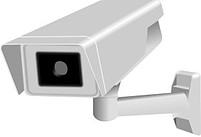 They are named box cameras due to their shape; they look like a rectangular box. The advantages of the box camera is the ability to replace, or if you like upgrade its components such as the enclosure, the camera lenses for better resolution. Additionally, a better lens camera can provide monitoring of areas farther away than the average 30-40 feet provided by most camera types. Box cameras are usually installed outdoors or inside warehouses, and can either be fixed or PTZ. On the other hand, if you do not mind the look, you can use one inside your house as well. These cameras provide Analog and Digital output. The Analog output could be either PAL or NTSC, but who uses these video formats anymore, anyway, at least in a home environment? A dedicated power supply is also required.
They are named box cameras due to their shape; they look like a rectangular box. The advantages of the box camera is the ability to replace, or if you like upgrade its components such as the enclosure, the camera lenses for better resolution. Additionally, a better lens camera can provide monitoring of areas farther away than the average 30-40 feet provided by most camera types. Box cameras are usually installed outdoors or inside warehouses, and can either be fixed or PTZ. On the other hand, if you do not mind the look, you can use one inside your house as well. These cameras provide Analog and Digital output. The Analog output could be either PAL or NTSC, but who uses these video formats anymore, anyway, at least in a home environment? A dedicated power supply is also required.
Bullet Cameras
Bullet cameras look a lot like the box one with the main difference
that all the components are sealed together and can not be replaced. If
a wider-angle lens is needed, then a new camera should be purchased.
Bullet cameras are smaller and cheaper than the Box cameras. They are
usually fixed IP cameras with Power Over Ethernet (POE) capabilities, which makes them ideal
for situations where installing extra cables is not a desired option.
Needless to say, for an extra cost, a PTZ bullet camera can be
purchased.
Dome Cameras
The camera is enclosed in a dome which is usually tinted to obscure the position of the camera. These cameras can be used outdoors as well indoors, and they come in different shapes and sizes. The smaller one are more appealing and can be mounted on the wall or the ceiling. The ones that are mounted on poles are usually bulky and condition for outdoor use. They can be either analog, digital, PTZ, or fixed and usually connected to a network using Cat5 or Cat6 cables and an IP address. Dome and IP cameras can be powered using POE through the Cat5/Cat6 cable.
IP Cameras
IP cameras are the type of cameras that can formed a networked by using distinct IP addresses. Some IP cameras also come with a web server that can be used to configure the camera in addition to using the server software the camera is managed by. The IP cameras are NOT directly connected to the NVR. The NVR server receives the video recorded by each camera in digital format, thus eliminating analog video conversion to digital. Therefore, the recorded video becomes available much faster. IP cameras are usually POE powered. IP configuration is beyond the scope of this post, but for any IP device to communicate with another IP device they both must be on the same local IP network. If two IP cameras have the same IP address only one of them will be visible on the system, and usually is the first camera powered on.
PTZ Cameras
PTZ stands for Pan Tilt and Zoom. Pan is the ability of the camera to move left or right, where Tilt is the ability to move up or down. Zoom is the function to take a closer of an item by zooming in closer to the item. The PTZ camera capability is a desirable feature and great to have. However, one needs to keep in mind that because of the moving parts for Pan and Tilt, the rate of failure of a PTZ camera is higher than of a fixed camera. Presets can be set for the PTZ camera, and when scheduled the camera will move, in a round-robin fashion, from a preset to another. Not all surveillance cameras are PTZ equipped.
Thermal Cameras
A thermal camera translates infrared radiation (heat) into an image called a thermographic image. HowStuffWorks explains in details How thermal imaging works
Since the thermal camera measures head, it does not require light and can work in total darkness. Dust, fog, clouds, and smoke have no impact on the camera’s functionality. These types of cameras are for specific high-security areas and I do not think a regular homeowner will use these type of surveillance cameras at his house. On the other hand, though, if you like to use one, don’t let anybody stop you from doing so.
WiFi Cameras
A WiFi camera transmits the video and audio signals through a radio to a WiF receiver. There are no cables involved and makes the WiFi camera ideal for locations that extra wiring is not desirable. For more details WiFi surveillance camera system – Design your home security
The only possible cable you might need is the one that will supply power to the camera. However, there are a couple of options to consider. The first one is to use a WiFi camera powered by batteries. In this case you should keep an eye on the batteries and replace them before they die. The other solution is to use solar energy powered WiFi cameras. The cost of course is higher, but it is an option to consider if nothing else works.
Conclusion
There are so many types and shapes of surveillance nowadays that selecting the right one offers some obstacles, hopefully, pleasant ones since learning about surveillance is not only fun but also educational and helps the individual make better decisions on his home security needs.
When choosing a surveillance camera you should base your decision on the following:
- The problem you are trying to solve
- The location of the camera, indoors outdoors
- The type of the camera, one of the types described above
- and finally the budget
Keep in mind number one. You are installing a surveillance camera to solve a problem, not to add more problems to the existing one.
A comprehensive list of camera types is provided by Wikipedia, List of Camera Types, and included more than just surveillance cameras.
Thank you for your time.
If you like, please leave your comments and suggestions below.


